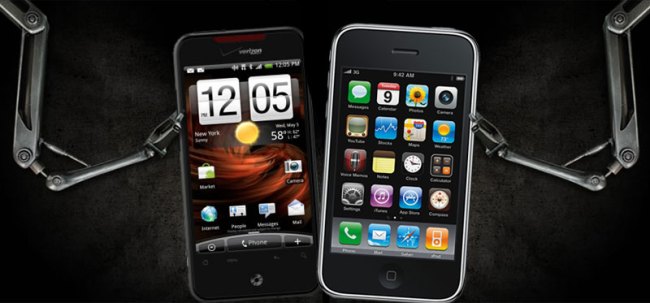
We have little doubt that HTC’s Incredible is king of the Android mountain for the time being. But even if it stares down at the myTouch puttering around in the foothills and the Droid on a craggy outcropping just below, it still has to measure up against that veritable Everest in the distance: Apple’s iPhone 3GS. How does the HTC Incredible measure up? Break out the altimeter and sextant, we’re going to find out.
 Display
Display
Winner: HTC Incredible
Few iPhone owners really complain about the 3.5-inch screen on the iPhone, but the HTC Incredible really has it beat in every regard. Besides measuring up larger at 3.7 inches diagonally, it boasts 480-by-800 resolution. As astute mathematicians will notice, that’s more than twice the resolution in Apple’s 480-by-320 LCD. Because it uses OLED display technology, it should also offer much brighter, more vibrant colors side by side, as the Nexus One does. (Anecdotally, most owners think the Nexus One looks better, but if you delve deep into technical minutiae, you can find an opposing viewpoint.)
Processor
Winner: HTC Incredible
Much as with the Motorola Droid, the beastly Qualcomm Snapdragon 1GHz chip powering the Incredible puts the 600MHz Arm Cortex A8 in Apple’s iPhone to shame. However, it’s worth noting that the iPhone has a dedicated PowerVR graphics processing unit, which endows it with gaming prowess well above and beyond what the CPU alone would lend.
Camera
Winner: HTC Incredible
Apple must plead no contest in this department. The iPhone 3GS has a 3-megapixel camera with autofocus, but no flash or manual controls. The Incredible offers an 8-megapixel shooter with dual-LED flash, plus on-the-fly adjustments for brightness, contrast, and ISO level. Likewise, the iPhone can only shoot VGA (640 x 480) video, while the Incredible can shoot video at the same resolution as its screen, 800 x 480.
Software
Winner: Apple iPhone 3GS
It’s a matter of taste, to be sure, but the overwhelming public preference still seems to favor Apple’s iPhone OS to Android. And as of iPhone OS 4.0, one of the biggest gripes about it – the inexplicable lack of multitasking – will disappear for good. Put that together with 185,000 apps in Apple’s App Store to about 40,000 in Google’s Android Market, and it’s hard to argue Google holds the upper hand at the moment.
 Battery Life
Battery Life
Winner: Apple iPhone 3GS
As with the Droid, we can’t claim to have hammered these out in laboratory tests just yet, but manufacturer estimates usually hold at least some water on cell phones – even if they’re all equally stretched. Apple rates its iPhone 3GS for 300 hours of standby, to the Incredible’s rather sad 146. That’s less than half. However, the Incredible claims 5.2 hours of 3G usage to the iPhone’s 5. When it’s that close, we would just assume call it a draw if Apple weren’t boasting over twice the standby time. On a hardware level, the batteries are nearly identical in capacity: 1219 mAh on the iPhone, to 1300 mAh on the Incredible.
Portability
Winner: HTC Incredible
Similar as they may be, the Incredible narrowly edges the iPhone out in all but what dimension. It’s a fraction slimmer, a fraction narrower, and a fraction lighter, but measures 4.63 inches tall to Apple’s 4.5-inch-tall iPhone. To any reasonable consumer, it’s a draw, but if you happened to be a lightweight backpacker looking for the ideal phone to drag you back to reality as you’re attempting to get away from it all, the Incredible just narrowly wins its place nestled beside the carbon fiber tent poles.
Memory
Winner: Apple iPhone 3GS
Much as with the Droid, you’ll find a different winner here depending on whether you prefer a phone that gives you the most value for your money, or a phone that can theoretically hold the most. The Incredible comes with 8GB of internal memory and a microSD slot that can handle up to a 32GB card (if you format on a PC first). The iPhone 3GS comes with either 16GB or 32GB built in, and no option to add more. Considering the 16GB iPhone and 8GB Incredible both retail for $200 with contract, we think HTC has the win. Technically, the HTC can offer up 40GB with a 32GB card installed, but given the $200 price tag on these cards at the moment, the iPhone still looks like the more practical decision for buyers seeking storage without complete disregard for their wallets.
Overall Winner: HTC Incredible
On paper, the HTC Incredible aces more categories than the iPhone, but without properly weighting the importance of each one, we don’t suggest you take this particular verdict to mean much. Apple’s dominance in software – especially its commanding lead in apps – probably means much more to potential buyers than a few extra millimeters here and there. That said, HTC’s hardware outmaneuvers Apple in just about every way possible, from an improved screen and microSD slot to an incredibly powerful Snapdragon processor and 8-megapixel camera. Is it really the superior phone? Depending on what’s important to you, absolutely.
Check out our other smartphone comparisons:
iPhone 4 vs. Android’s Best: Spec Face-Off
Motorola Droid vs. HTC Incredible
Check out our full HTC Droid Incredible and iPhone 3GS reviews.
Editors' Recommendations
- Why you should buy the iPhone 15 Pro instead of the iPhone 15 Pro Max
- 3 reasons why I’ll actually use Anker’s new iPhone power bank
- There’s a big problem with the iPhone’s Photos app
- How to use iMessage on an Android phone or tablet
- 10 iPhone productivity apps you need to download right now
 Display
Display Battery Life
Battery Life

